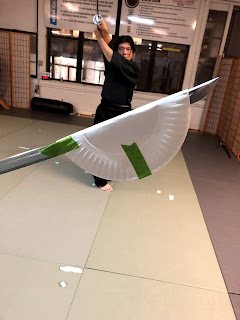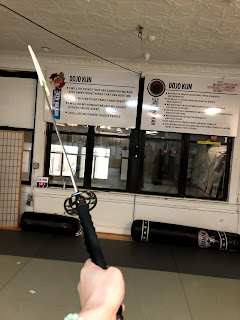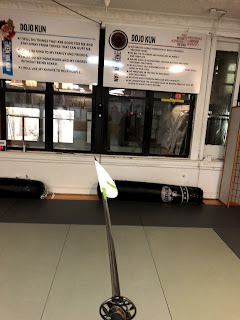Blade Angle Visual
No matter how soft the mat that you're cutting or the sharpness of your sword, if you scoop, you'll get stuck (or make a very horrendous cut if it goes through). It is difficult to fix as well because it's hard to see yourself what angle your blade is during the middle of a swing.
So what does this mean?
One big cause of these positions is the position of the left hand and elbow. Let's take a look again.
For the scoop, you can see that the left elbow is pretty low and that the left hand is off center. This leads to your hand turning which causes it to go flat.

When I first started, I had a problem scooping on one side as most do and I was trying to find ways to correct myself. I would get hasuji sometimes but not consistently.
When I was trying to practice at home in my garage or outside, I didn't have a mirror so I had to find a way to see my blade angle. When I was taught, I was told that the blade angle is correct if you only saw the mune (back of) the sword whether you're watching someone do it or from your own view.
Well, we didn't have as many Kotetsu's or Paul Chen XL's back then so it was hard to see whether your blade was turned or not. So I found some cardboard in my garage to make a wider "profile" to help analyze.
It's quite easy to do! Just get a paper plate, or cardboard etc, and then fold it in a way that it would fit and be part of the blade. Find some tape to keep it in place. This wasn't planned that day so we just found a paper plate haha.
First, is what you would be able to see yourself.
This is if the blade angle is correct. You should not see much of the paper blade.
Example 1
This next one is if you're scooping or making the blade to flat. You'll see the paper. This one would definitely be a cut that you get stuck in the mat.
Example 2
Aiya...
Now if you're looking at it from an outside view.
Example A
ok
oh...starting a bit...
stuck in the mat
Do you see how much you see the paper plate?
Now, you can also see if the edge is too steep (harder to see though)...
Example B
ok
Hmm...
If you look close, you can see the plate being pushed to the side..
This time you can see the other side of the plate
Usually, this can lead to a steep cut
Example C
ok
ok
blurry
finishing up...ok!
So what does this mean?
One big cause of these positions is the position of the left hand and elbow. Let's take a look again.
For the scoop, you can see that the left elbow is pretty low and that the left hand is off center. This leads to your hand turning which causes it to go flat.
Do you see how much you see the paper plate?
If it tends to go on the steeper side, notice that the left elbow is higher than the right elbow this time. This can also be seen by the shoulder going higher up. One big cause of this as well as finishing the left hand too high at the end of the cut. The ideal spot the left hand should finish is around your "hara" or about under your stomach/belly.

With this exercise, it's a good way to study your own movement. Another part of it is that if your blade angle is correct, you don't feel any resistance from the paper. The direction of the paper will further push your blade to turn that way. If you just cut straight down, you'll feel that too if you're blade angle is not right.
Anyways, hope this helps!!! Remember though, if you do better and improve your hasuji, remember the "feeling" that your body had when you were doing the swing correctly. That way, when you take off the paper, you'll still be able to reproduce that proper angle and your hasuji will be louder! Otherwise, you're wasting a plate and tape.
Also, this only really helps with downwards cuts but not sui hei or gyaku kesa because of the view of the cut. Thank you to Yuliya and Rob for helping out.






























Comments